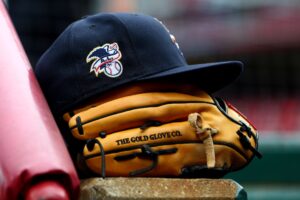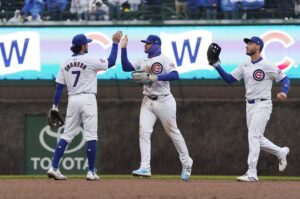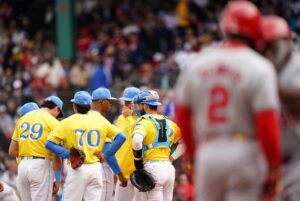Catching depth is a serious concern for many MLB teams and the Colorado Rockies are no exceptions. The burdens of defense and pitch calling have drastically changed how the position is scouted and developed. There are a few semi-reliable options in the organization, but who will turn into the catcher of the future?
Colorado Rockies Catching Depth
Major League Level
Last season’s starter, Tony Wolters, is no longer with the team after being non-tendered earlier in the offseason. His departure is not a great loss after the past two seasons saw the 28-year-old contribute -1.1 combined WAR in 520 plate appearances per FanGraphs. His pitch framing and defensive runs saved had deteriorated alongside the mediocre offensive production. Letting Wolters go leaves Elias Diaz as the only catcher on the 40-man roster to appear in a game in 2020. The 30-year-old wasn’t much better at the plate than Wolters, but his wRC+ of 58 was superior to Wolters’ 37 in about two-thirds as many plate appearances. Diaz doesn’t provide as much defensive skill, but trading that for a better bat could be the decision for 2021.
AA & AAA
The best catcher below the major leagues is easily Dom Nunez, the only other catcher on the 40-man other Diaz. Nunez easily slides into a role at the top level now that Wolters is gone. Nunez’s last appearance with the Rockies was in 2019 when he slashed .179/233/410 in 43 plate appearances. That sample size is obviously too small to draw any conclusions, so minor league stats are important to factor in here. That is where Nunez intrigues. He hit .244/362/559 in 2019 with AAA-Albuquerque.
Of course, Colorado’s minor league parks are known for inflating offense. For reference, Denver is famously right at 5,280 feet above sea level. but Albuquerque, New Mexico is a touch higher at 5,312. Former affiliates in Lancaster, CA, Boise, ID, Grand Junction, CO and Asheville, NC were all 2,000 feet or more above sea level.
Catching depth behind Nunez is a collection of mostly unknown talent. The headliner is Jose Briceno and his 134 ML plate appearances. However, Brian Serven is probably the next-best option above High-A. The former fifth-round pick from 2016 hit .202/286/364 with nine home runs in AA in 2019. That isn’t great, but it’s something to watch considering how little upper-level depth exists. Chris Rabago rounds out the upper minors as a very mediocre 27-year-old.
High A & Below
Shifting to the High-A team is where things get interesting. The conversation in the lower minors starts with the 2020 draft pick, Drew Romo. A shortened high school season and lack of minor leagues meant Romo had almost no stats this year, but he graded out as one of the five best catching prospects in the draft this year. The switch-hitting backstop had perhaps the best glove of anyone and looked fine at the plate against some of prep baseball’s top talent. His development is one to watch, even if it will be years before the 19-year-old reaches the majors.
Fans can satisfy their curiosity with someone like Willie MacIver in the meantime. The Rockies drafted the 6’2″, 205-pound backstop in the ninth round of the 2018 Amateur Draft and have watched him post two above-average minor league seasons. The 276th overall selection has a career .262/331/428 slash line and 18 home runs in 698 plate appearances. The most intriguing of MacIver’s stats is a wOBA that has been above .330 this indicates a solid ability to contribute to overall run-scoring.
The rest of the catching depth isn’t particularly exciting, but there are some things to note. 2017 selection Austin Bernard had a 16.1 percent walk rate in 322 plate appearances for High-A Lancaster in 2019. Max George is a converted infielder with a wRC+ above 100 in six years in the minors; Colorado only converted him prior to 2019 so his development has taken longer as a result. Finally, one-time top 30 prospect Ronaiker Palma rounds things out. The 2017 Venezuelan signing might only have the ceiling of a backup, but he’s hit .285/328/340 and has good defensive projections. He’s another one to monitor heading into the 2021 season.
Overall Thoughts
This does not look like a good group of catchers, but the position has seen an increased emphasis on defense over offense for years. Such a trend affects many teams, not just the Rockies. That could change if/when an automated zone is introduced, which can only benefit a chunk of the catching population. The Rockies have watched the position decline from a wRC+ of 68 in 2018 (when they last reached the postseason) to a putrid 35 in 2020. It’s borderline impossible for their catchers to be less productive at the plate. It’s not as though the position’s defense is any better.
The team ranked in the bottom third for both defensive runs saved and framing in 2020. Decline in catcher hitting league-wide is something the automated zone will address; the position had a collective wRC+ of 90 in 2020, but that was the highest mark since 2017. There are some ebbs and flows as with any position, but catching is struggling per this piece from 538 earlier this year.
The biggest thing Colorado can hope for is the automated zone. That can only help shift organizational focus from receiving to hitting and maximizing the effects at Coors Field. Giving options like Nunez and Romo less burden on pitch-receiving could produce huge returns at the plate. It might take a few seasons, but the environment for catchers could shift dramatically in favor of what the Rockies have stockpiled.
Main Image:
Embed from Getty Images






